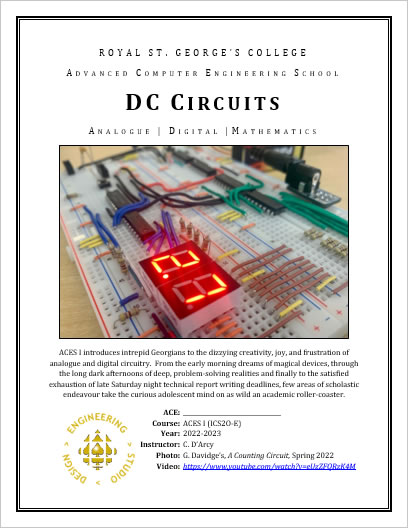COURSE |
|
ICD2O-E |
 |
| NAME |
|
Introduction to Computer Studies, Engineering Emphasis |
TYPE |
|
Open |
DATE |
|
2025 01 20 |
DOCUMENTS |
|
Computer Studies, The Ontario Curriculum, Grades 11 and 12, 2008 |
|
|
Growing Success: Assessment, Evaluation and Reporting in Ontario Schools,
2010 |
INSTRUCTOR |
|
C. D'Arcy |
CREDIT |
|
0.5 |
HOURS |
|
55 |
PREREQUISITE |
|
none |
MATURITY |
|
5 (0-New course; 5-Established) |
|
OVERVIEW |
|
This hands-on half-course builds on the Science 9 Unit, Introduction to Electricity. Students work their way through concepts in and analog and digital circuitry employing curriculum designed specifically for our RSGC ACES program. Topics include power, design and prototyping of analog circuits, logic, semiconductors, integrated circuits, communication as well as safety, environmental, and societal awareness. This course provides the foundation for our subsequent ICS3U-E AVR Foundations course. |
 |
EMPHASIS |
|
Part 1 of this course focuses on the fundamental electronics underlying
all computer technology. |
|
| RESOURCES |
|
DC Circuits, 6th Ed, C. D'Arcy. Design Engineering Series. 2022.
Toolkit
ACES' Web Site
|
 |
| STRATEGIES |
|
Units are project based. Teacher demonstrations and hands-on
circuit research and assembly provide the students with the necessary
terminology and methodology to meet the expectations. Classroom discussions,
collaborative and co-operative learning, research, report writing
and taking notes will assist students in achieving success.
Upon completion of this course, students will demonstrate the ability to
apply skills and knowledge to practical situations that
involve the completion of work assignments and problem-solving
activities. |
 |
| EVALUATION |
|
Design Engineering Report: 70% (Formal Reports of In-Class Projects)
A Counting Circuit
: 30%
Categories of Assessment:
Knowledge & Understanding/Thinking, Problem-Solving/Communication/Application |
|
| STRANDS |
|
Fundamentals: basic components, digital logic, integrated circuits |
|
| |
|
Skills: measuring and analyzing circuit properties with a digital multimeter, reading datasheets and schematics, breadboard prototyping, circuit board assembly and soldering, circuit encasement design and implementation, advanced Word techniques, technical writing, video presentation techniques, etc. |
|
| |
|
Technology and Society: environmental and health issues |
|
| |
|
Professional Practice and Ethics: Canadian Council of Professional Engineers
Code of Ethics |
|



